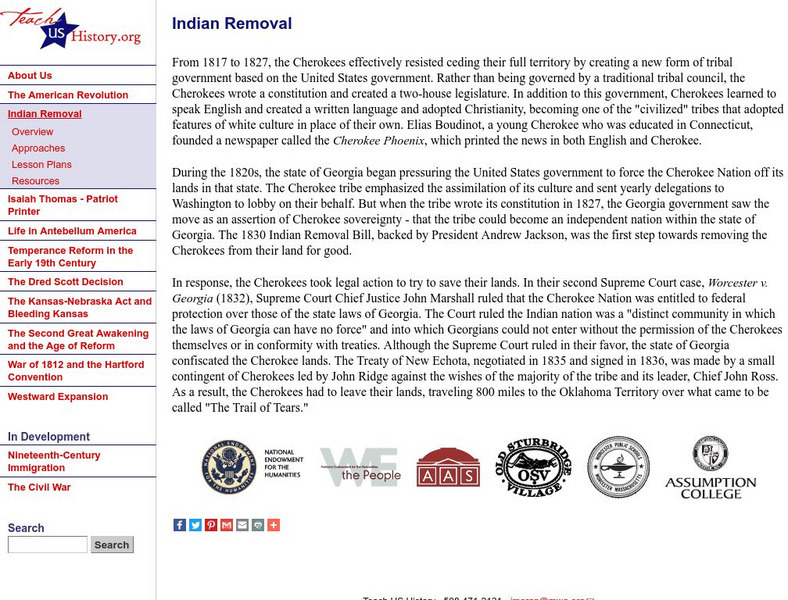Hi, what do you want to do?
PBS
Pbs: Indian Pride: Historical Overview: Lesson Plan
Students will develop an understanding of major United States history and policy and develop awareness of the impact and integral role American Indians and/or sovereign cultural groups play in United States history.
National Endowment for the Humanities
Neh: Edsit Ement: Traditions and Languages of Three Native Cultures
This lesson plan helps students learn aspects of three Native American languages, the Tlingit, Lakota, and Cherokee. Five lessons lead teachers and students through traditions, similarities and differences, and the importance of...
Alabama Learning Exchange
Alex: Historic Indian Tribes of Alabama
This lesson will focus on researching, analyzing, and comparing the culture of four Indian tribes from Alabama's history. The rich culture of the Cherokee, Creek, Chickasaw, and Choctaw Indian tribes contributed to the rich history of...
Library of Congress
Loc: Teachers: Indian Boarding Schools
The Library of Congress provides a series of lessons that taddresses historical efforts of assimilating Native American children into white culture through boarding schools.
Library of Congress
Loc: Immigration: Destroying the Native American Cultures
Detailed and extensive account of the plight of Native Americans during the westward growth of America. Includes maps, audio recordings, authentic letters, speeches,a great timeline, and much more.
University of California
History Project: The Removal of the Cherokee Nation
Middle school lesson plan attempts to answer the question of the government's Indian policy and its relationship to the Cherokee. Students will use sections from 26 primary source documents to aid in the research.
Other
Teach Us History: Indian Removal
A lesson unit that looks at the efforts of the Cherokee Nation in Georgia between 1817 and 1827 to establish their own system of governance and to keep their lands from being ceded. Even though the Supreme Court ultimately ruled in their...
Gilder Lehrman Institute of American History
Gilder Lehrman Institute: History Now: Events at Sand Creek, 1864
[Free Registration/Login Required] A great lesson plan about an incident that receives little coverage in most textbooks. This plan lays out the objectives and procedures for learning about and discussing the actions of Col. John...
Stanford University
Sheg: Document Based History: Reading Like a Historian: Battle of Little Bighorn
[Free Registration/Login Required] Students solve a problem surrounding a historical question by reading primary source documents. This historical inquiry lesson allows students to explore causes of the Battle of Little Bighorn by...
iCivics
I Civics: Tribal Government
As sovereign nations, American Indian and Alaska Native tribes develop and manage their own governments. This lesson examines the varied structures and functions of tribal government as well as the relationship these nations have with...
Ohio State University
Osu History Teaching Institute: Native American History: John Smith and the Powhatan
This lesson relates to understanding primary sources to evaluate John Smith's description of the Powhatan Indians.
Library of Virginia
Virginia Memory: Blank Space: Mapping the Unknown
How did early maps show the mapmakers' perception of the known world? Early mapmakers used maps drawn from coastal explorations, land travels, and even information heard word of mouth from American Indians or from colonists or traders....
Ohio State University
Osu History Teaching Institute: Indian Removal
This lesson looks at the process whereby a policy of assimilation gave way to one of overt removal under President Jackson.
PBS
Wnet: Thirteen: Whose Land Is This? Conflict Between Native Americans & Settlers [Pdf]
A lesson plan from the producers of the 16-episode PBS series "Freedom: A History of US" designed to provide insights into the causes of the conflict between Native Americans and new settlers pushing west. Students will examine official...
PBS
Pbs: The Living Edens Manu, Peru's Hidden Rainforest
Read about Peru's "hidden" rain forest-Manu. This site provides in-depth information about the flora and fauna of the region as well as conservation efforts and the history of the area. There are additional resources for the classroom...
National Endowment for the Humanities
Neh: Edsit Ement: Kennewick Man: Science and Sacred Rights
Excellent, thought-provoking lesson plan on the controversy over the remains of what is known as the Kennewick Man. Should they be considered as remains of a Native American ancestor and thus be buried or should scientists be allowed to...
Arizona State University
A.r.t.s : Navajo Pottery: Beautiful Objects
This informative website contains pages discussing the history of Navajo pottery. Provides photos and explanations of various pottery techniques. Teachers can use these lessons to show students how to create and fire their own pottery!
Alabama Learning Exchange
Alex: Extra, Extra!! Mary Rowlandson's Captivity Newscast
This lesson will be an interdisciplinary lesson that involves both English Language Arts and Social Studies (History). The lesson will be primarily technology-based and also project-based that will have the young scholars performing...
Ohio State University
Osu History Teaching Institute: Homestead Act of 1862
Through the use of primary sources, 4th graders will understand the main concepts of the Homestead Act and use that information to write a letter to a relative explaining why they moved to Ohio.
Other
Teaching Tennessee History: Lesson Plans for the Classroom Volume X [Pdf]
These lesson plans are designed to integrate language arts and primary sources into elementary social studies instruction.
PBS
Pbs:the Living Edens/manu Native People of Manu
An article on the Machiguenga, the native people of the Manu rainforest in Peru. This article talks about their culture, history, and their use of plants and animals.
Library of Congress
Loc: Teachers: Journeys West
A series of lessons utilizing primary texts, including narratives, photographs, and maps, through which students explore the following question: "What motivated thousands of people to journey west during the 1800s?"
US National Archives
Nara: Teaching With Documents: Sioux Treaty of 1868
The National Archives and Records Administration highlights the Sioux Treaty of 1868. The lesson provided here relates to the power granted to the president and the Senate in Article II, Section 2, Clause 2, of the U.S. Constitution, the...

















